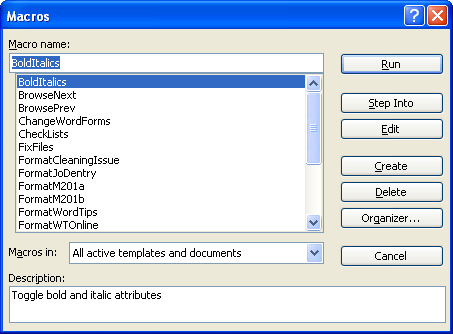

- #Macro commands for word 2010 how to#
- #Macro commands for word 2010 code#
- #Macro commands for word 2010 download#
Under Symbol, click the symbol that you want to use for your button. Under Choose commands from dialog box, click the macro that you are recording, and then click Add. To make your macro available in all documents, be sure to clickNormal.dotm.

Under Customize Quick Access Toolbar, select the document (or all documents) for which you want to add the macro to the Quick Access Toolbar.
#Macro commands for word 2010 code#
On the Developer tab, in the Code group, click Record Macro.īegin recording: To begin recording the macro without assigning it to a button on the Quick Access Toolbar or to a shortcut key, click OK.Ĭreate a button: To assign the macro to a button on the Quick Access Toolbar, do the following: Click Button. Under Top options for working with Word, select the Show Developer tab in the Ribbon check box. I have spent a lot of time researching the internet and trying various things, but I would ultimately like to get them set so that they design their preferences once, and it will stay that way on a global scale.Ĭlick the Microsoft Office Button and then click Word Options. What would be ideal is to create and save macro's as well as the font and page setting in Word and have them present on a global scale, whether creating a new document from within the office, or pre-setting a client-supplied document for their files (case). DOC fileĪt all, forcing the paralegals to go through the formatting from scratch. In researching the internet we found a solution, more like a band-aid to be fair, to directly modify the 'normal' template in the user's hidden folders area which does work, however the formatting in that template will not modify a client supplied. With Office 2010, they can record and save a macro, but if they quit out of Word and re-open it again, the icon for the macro still exists in the top toolbar, but the macro function is no longer there.Īlso, we have gone through and saved the font as default for all future use of Word, however when it's re-opened, it goes back to a different font and page format than what they need. This would ensure consistency in their documents as well as those that are entered from a client into their files. They would also set their format to have a specific font type, size, page format, etc.
#Macro commands for word 2010 how to#
If you’re confident messing about with VBA for Word, the code is commented to show you how to adapt it to cover any other subscript/superscript formulae that you use regularly.Įdit: A macro which does the same kind of thing, plus fixes some common typos (KWh for kWh, etc.) for Excel is now available here.I am an IT professional for a law firm who was just recently upgraded to Microsoft Windows 2010.īefore when using Windows 2003 they would be able to record and save macro's to minimize keystrokes for repetitive tasks, etc. Next you can add an icon so you can find it easily. I’ve hijacked the π symbol which normally serves as the insert formula button but you can add whatever makes sense to you. Just click Modify and select an icon from the options that appear. Then find in the list that appears and use the Add > button to move it across to the Quick Access Toolbar. To add a button to the Quick Access Toolbar in MS Word 2010, first click on the down arrow at the right hand end of the row of icons that includes the Save icon, then select More commands -> Choose commands from -> Macros. It’s so handy that I also decided to add it to the Quick access bar for easy access (MS Word 20 only). To add the macro to the Normal template open up MS Word and press Alt-F11 to open the VBA editor window -> Ctrl-R to show the project explorer (if it isn’t already showing) -> right click the Normal template -> Import file -> browse for the FormatFormulae.bas file -> Open, and you’re done.
#Macro commands for word 2010 download#
Just download and unzip the file from the link below, then import it to your Normal template in MS Word. It needed a bit of adaptation to do exactly what I wanted but it’s now a real time saver. Eventually I found what I was looking for on G Mayor’s site. Instead I hunted around on the net for a way of correcting it automatically using a macro.

My contribution here is from the point of view of someone who edits quite a lot of other people’s reports as well as writing my own, in which case you can’t rely on the autocorrect method. It’s a handy approach and saves your work from the annoying critic who ignores your carefully crafted argument while pointing out every last formatting error. Mel Starrs has just posted a handy time-saving tip over at Elemental which explains how to use MS Word’s autocorrect feature to ensure that your CO 2 subscript always comes out right.


 0 kommentar(er)
0 kommentar(er)
